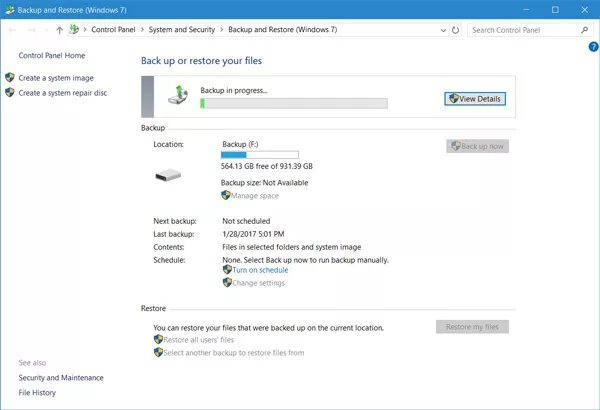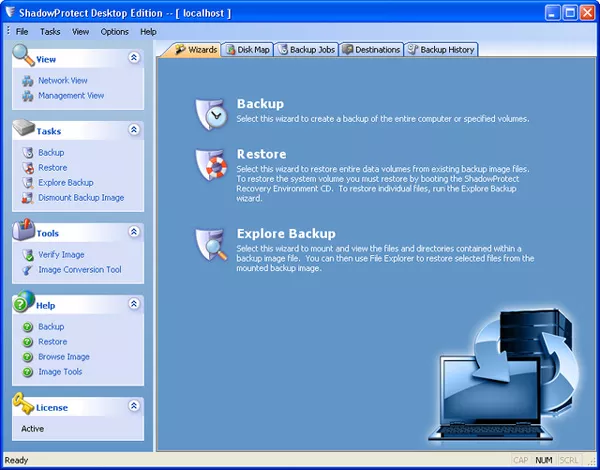Friends ask me this question a lot: Is Windows backup enough or should I consider paying for another product? The truth is, software backup and imaging solutions are critical to the success of companies both large and small. They have been around a long time. And yet they are one of the most confusing products on the market today. When dealing with files that are critical to your work, the last thing you want is confusion. I'm convinced a lot of the confusion stems from how Windows presents its backup features. 
 Microsoft could do a much better job at explaining the differences between the backup options they offer within Windows 10. Although I've performed this backup a number of times, I'm never quite sure I'm doing it correctly. If there's one task you perform on your PC that needs to be clear and concise, it's the backup process. As it currently stands, the options within Windows 10 are confusing to many users. And when users get confused, they tend to leave things alone which is a shame. Because Windows 10 includes some decent tools - they should be much easier to use.
Microsoft could do a much better job at explaining the differences between the backup options they offer within Windows 10. Although I've performed this backup a number of times, I'm never quite sure I'm doing it correctly. If there's one task you perform on your PC that needs to be clear and concise, it's the backup process. As it currently stands, the options within Windows 10 are confusing to many users. And when users get confused, they tend to leave things alone which is a shame. Because Windows 10 includes some decent tools - they should be much easier to use.  Selecting "Explore Backup" lets you restore files or folders quicklyPerformance: I won't go into the technical details, but the more advanced tools are able to take an image and restore an image in less time than many of the free options. This is due to how they backup and access the data. You should never have to give up reliability for speed. But when a system goes down, the faster you can restore it the better off you'll be.
Selecting "Explore Backup" lets you restore files or folders quicklyPerformance: I won't go into the technical details, but the more advanced tools are able to take an image and restore an image in less time than many of the free options. This is due to how they backup and access the data. You should never have to give up reliability for speed. But when a system goes down, the faster you can restore it the better off you'll be.
Windows Backup vs Paid Imaging Solution
This week, I want to look at some of the features you can expect when purchasing imaging software, such as StorageCraft's ShadowProtect. What are some of the features you get with a paid solution that you might not find in Windows or with a free product? What features actually matter, when considering Windows backup solution vs paid backups? I'll explore these questions and a few others today.
Imaging vs Cloning
Before I begin I want to start by clarifying the difference between drive imaging and drive cloning. I've heard a lot of people use these terms interchangeably - however, they are not the same.Drive Imaging: Imaging products create a compressed file of your operating system that includes all the files you need to run Windows, plus all files and programs on that drive. The image is created as a single, compressed file that's usually saved on an internal or external drive. Advanced imaging products can take incremental images, save images to the cloud and even mount images from the cloud. Imaging provides the user with the most options which I'll discuss below.Drive Cloning: Cloning basically takes an exact replica of your drive. Because it is not compressed, it can be used immediately as a primary drive. There's no such thing as incremental cloning. You can overwrite a cloned drive if you need to. This is a great solution for those who can dedicate another drive to the process. Some people confuse drive cloning with RAID 1. That's not the case, and is outside our topic today. While it helps to understand the distinction between imagine and cloning, I'll primarily be discussing imaging solutions today.The Windows 10 Approach
Windows 10 breaks down its backup solution into two parts: File History and Image Backups. Turning on File History will tell Windows to occasionally backup the files you save to Windows Libraries. That includes files saved to your Documents, Music, Pictures and Video folders as well as your browser Favorites. This is backup in its most basic form. It might save you in a pinch, say if you accidentally delete a file. But I don't consider a full backup solution. Windows also includes an imaging solution it calls Windows 7 Backup and Restore. Below is a screen capture of this process on my PC as I write this article. I told Windows to perform an image backup of my primary drive (C:) and save that image to another internal drive (F:). The whole process takes about an hour. Once Windows has completed the image creation, I can restore that image if my computer begins acting up. The restore process takes about 40 minutes. Windows doesn't give me a lot of options, side of which drive to backup and where to store the image. For desktop users who aren't looking for many options, this free solution might work just fine for them.
Dedicated Imaging Tools
These are tools that have been built from the ground up to help you backup your system. They perform the basic backup and imaging process without any drama yet they also include helpful features that make them more valuable than free options. Dedicated imaging tools give professionals a lot more control over the entire imaging process. They work well not only on desktop PCs, but also workstations and servers. Some work well within virtual environments as well. Let's take a look at some of the feature these products include:Scheduling: The best tools give you concise control over when you perform a full image backup and incremental backup. They also allow you to select how many incremental backups to keep. I take a full backup each week as well as a nightly incremental backup. The best tools make this information easily available and simple to change.Remote Management: Managing the backup for one computer is one thing. But when you're responsible for dozens or even hundreds of systems, remote management of the backup process is critical. A lot of the free tools lack any type of remote management. This process works but installing backup agents on the client machines and then remotely managing the process from the tool's administration console.Incremental Backups: Incremental backups only backup the data that differs from the time you took a full system image or the last incremental. A number of the free tools allow you to take incremental backups, but don't give you a lot of control over how many to keep. Some of the more advanced tools will allow you to set a storage limit, and then allow incremental backups to run until you reach that limit. This is very helpful if your storage capacity changes frequently.Reliability: An image is only viable if you can restore it. Anyone who has taken dozens or hundreds of images has probably had to deal with a corrupted image. Look for a product that will both test and verify the integrity of your image. Most of the free tools don't include image verification. That means you're playing Russian Roulette with your system because eventually you'll take a bad image.Recovery Options: The advanced tools give you more recovery options. Maybe you only need to recover a few folders or files. The best tools allow you to mount the image within Windows. Once mounted, the images acts like a regular drive. You can copy and move images from the backup to your local drive. This option is handy if you need to quickly access just your folders or files. Some products even allow you to mount and run the image from a cloud service.
Conclusion
The backup and imaging options available in Windows 10 may be enough for some home users. Even some of the free options might work. Be aware that most of them will nag you to upgrade to the paid version. To decide whether you need to pay for a backup solution, versus just using the free Windows tools, you might want to ask yourself a few questions:- Are you looking for a high level of reliability on recovery?
- How important is your data - are you bound by industry regulations to back it up?
- Do you need to manage multiple systems?
- Do you often test your backups and recovery capability?
You May Also Like
- Uncategorized
5 Steps to Building an Effective Ransomware-Free Data Protection Strategy
July 5th, 2021 - Business Continuity Uncategorized
Arcserve & StorageCraft: The New Business Continuity Leader
February 24th, 2021